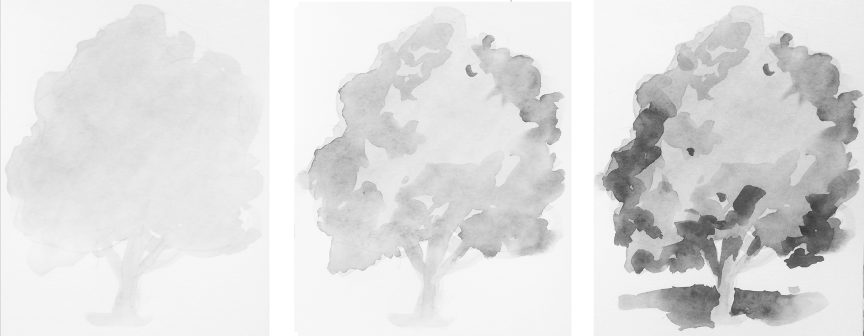Value range and light source are two fundamental and important we need to consider when we are starting a new painting. Value refers to lights and darks, and it’s often talked about in terms of a 0 – 10 scale, as in photography. Your light source, or awareness of the direction light is coming from, and the strength of that light, has a profound influence on the location and intensity of bright areas and and dark ones.
Here is a little exercise to help you understand and practice with light sources and value.
Below are four sets of tree images. Each set has three images showing three wash layers. The light source in each set is from a different direction.
The procedure is exactly the same as for the other tree exercises you’ve been doing. Put down your layers, letting each layer dry before applying the next one. You will be using a made-up image of your own. It doesn’t have to be a tree, but I like using trees for this exercise because it is very easy to observe in nature how light sources work on them. Buildings and houses work well too. Their big plane surfaces make very clear how light direction affects light and dark areas (we call this phenomenon “value”).
Here are the images you’ll be using for reference.

In this version, THE LIGHT SOURCE IS AT RIGHT, close to the horizon. Note the direction of the shadow.

Here, THE LIGHT SOURCE IS DIRECTLY IN FRONT and it is low to the horizon. Again note that the shadow will fall almost entirely behind the tree. If the light source rises higher above the horizon, more of the shadow will fall in front, and the light on the trunk will be lower.

In this one, LIGHT SOURCE IS AT LEFT, just above the horizon. Shadow is on the right.

Here the LIGHT SOURCE IS BEHIND THE TREE, so the tree is backlit, and the shadow falls in front. This one is probably the most challenging and the most dramatic. So it is kind of fun!
I hope you’ll enjoy this exercise.
Here’s another little mental exercise that requires no paint, paper, drawing book, or any other art materials…and not a lot of time. As you go about your day, notice the trees and buildings around you. Take a careful look at them. Check out where the light is coming from, and see how light direction affects where the bright areas are and where the shadows fall. Note how the light changes these aspects as the day proceeds.
Also, carry a drawing book with you, and if you have 10 or 15 minutes of down time, find a tree or building and try to draw it as you see it. This will give you good practice in several areas: your values, your interpretive skills (figuring out how to render what you see), AND ability to analyze light sources.
Okay, go for it and have fun!